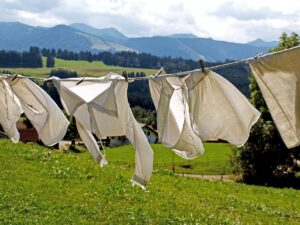 In Richard Wilbur’s delicate poem “Love Calls Us to the Things of This World,” the bedsheets hanging on the clothesline become angels, swelling with the breeze and letting us feel the “deep joy of their impersonal breathing.”
In Richard Wilbur’s delicate poem “Love Calls Us to the Things of This World,” the bedsheets hanging on the clothesline become angels, swelling with the breeze and letting us feel the “deep joy of their impersonal breathing.”
In my dryer, they tumble, inert.
Clotheslines are at once homespun and ethereal, whether they are strung across apartment buildings in Brooklyn or overlook a field of sunflowers in the Midwest. My grandpa’s union-suit underwear and my grandmother’s aprons used to hang side by side in the backyard, getting along better than they ever did. And how fresh the sheets and rough-dried towels used to smell, like sunshine and grass and real cleanliness, not its chemical imitation.
Does anyone even use clotheslines anymore? To my delight, they are strung all over the internet. Thank the back-to-nature hipsters and the old folks roving the country in their RVs. Clotheslines are in some ways the ultimate luxury, solar- and wind-powered, relying on no machines. The Old Farmers Almanac still suggests cotton clothesline, not the new synthetics: “Unless you’re hanging out pots and pans to dry, it should hold up fine.” Also, I am glad to see that despite the proliferation of cheap, overbright, practical but planet-strangling plastic, the clothespins must be wooden—this remains the consensus. Some guy named Kevin is making a fortune selling handmade ones at a price that would have made my grandmother apoplectic.
I gave up bothering with clotheslines years ago, and my clothes do not smell right anymore. Their scent is flat and cardboardy, artificially sweet, or harsh with bleach. I tried rigging a line across our tiny backyard when we were first married, but for a litany of whiny excuses—it was too humid; there was pollen flying—I usually wound up hanging clothes in our dank basement. How did my forbears manage? Surely they had humidity and pollen; they were in St. Louis, where the weather is glorious for a few weeks in spring and fall, then zigzags to extremes of heat or cold, mugginess and roaring thunderstorms, ice storms, flooding, or drought.
A vague memory drifts back: thunder rumbling, and my Aunt Mary hurrying to fetch the laundry off the line, plucking each garment from its clothespins with nimble, red-knuckled fingers, tossing it all into a jumbo basket. Yet in my mind’s eye, a soft breeze always billows the sheets, and the sunlight streaming through them turns them a translucent white, fit to drape a saint.
Traveling, I often wound up photographing clotheslines. A rainbow of laundry hung between cottages on the rocky coast of Newfoundland. Clothes drying instantly in Haiti’s hot sun, and the children parading to Catholic school every morning in immaculate pastel uniforms even though no one had electricity, let alone appliances.
For some morbid or elegiac reason, I often photograph cemeteries, too. Silent as their marble, they hold still, containing the shapes of death. But clothes on a line will dance all by themselves, waiting for a warm body to fill them.
Wilbur’s poem is set at first light, and he watches the laundry angels “swoon down into so rapt a quiet/ That nobody seems to be there.” This is the break of day; life is about to be cluttered with obligation and routine. The fresh purity of dawn will be smashed to smithereens. We will put on these heavenly robes and spill raspberry jam on them; spatter our immaculate shirts with leaky inkpens; plop down on the grass then stand up with our khakis stained.
Temporarily.
Laundry is a sort of redemption. It erases the messes we make and gives us a fresh start. Wilbur’s clean linen will be worn by thieves, by nuns, and by lovers who go “fresh and sweet to be undone.” They will all end, one way or another, between the bedsheets, the place for passion, prayer, or the tossing and turning of a guilty conscience. All the drama will come out in the wash. As always, we will return to the mundane, the fabric of our lives rinsed clean so we can start again.
